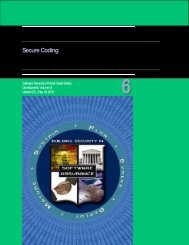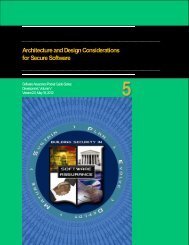SwA in Education, Training & Certification - US-Cert
SwA in Education, Training & Certification - US-Cert
SwA in Education, Training & Certification - US-Cert
You also want an ePaper? Increase the reach of your titles
YUMPU automatically turns print PDFs into web optimized ePapers that Google loves.
Overview<br />
Current events related to cybersecurity encourage a<br />
fundamental shift <strong>in</strong> the way we th<strong>in</strong>k about<br />
educat<strong>in</strong>g and tra<strong>in</strong><strong>in</strong>g a workforce prepared to<br />
address security issues <strong>in</strong> all phases of a software<br />
system. Software assurance education and tra<strong>in</strong><strong>in</strong>g<br />
touches on software eng<strong>in</strong>eer<strong>in</strong>g (<strong>in</strong>clud<strong>in</strong>g its many<br />
sub-discipl<strong>in</strong>es), systems eng<strong>in</strong>eer<strong>in</strong>g, project<br />
management, and other discipl<strong>in</strong>es (shown <strong>in</strong> chart<br />
Key <strong>SwA</strong> Knowledge Areas and Efforts, page 6, beloThe goal is to fit the workforce with the ability to identify and<br />
acquire the competencies associated with secure software. The primary audiences for this pocket guide are educators<br />
and tra<strong>in</strong>ers who can use this guide to identify resources to supplement their efforts as well as to identify strategies to<br />
<strong>in</strong>ject software assurance related topics <strong>in</strong> the exist<strong>in</strong>g education and tra<strong>in</strong><strong>in</strong>g programs.<br />
The objective of software assurance is to ensure that the processes, procedures, and products used to produce and<br />
susta<strong>in</strong> the software conform to all specified requirements and standards. Software assurance <strong>in</strong> its broader sense<br />
refers to the assurance of any required property of software. However, <strong>in</strong> the context of this pocket guide, software<br />
assurance is concerned with assur<strong>in</strong>g the security of software.<br />
Build<strong>in</strong>g secure software requires a workforce that understands the processes and technologies that provide the basis<br />
for belief that software will consistently exhibit all properties required to ensure that the software will operate as<br />
expected, despite the presence of faults <strong>in</strong>troduced by a malicious adversary. The Ware Report (1969) identified that:<br />
“Probably the most serious risk <strong>in</strong> system software is <strong>in</strong>complete design, <strong>in</strong> the sense that <strong>in</strong>advertent loopholes<br />
exist <strong>in</strong> the protective barriers and have not been foreseen by the designers.”<br />
Later the Anderson Report (1972) clearly established the technical problem to be solved as that of:<br />
“…determ<strong>in</strong><strong>in</strong>g what constitutes an appropriate defense aga<strong>in</strong>st malicious attack, and then develop<strong>in</strong>g hardware<br />
and software with the defensive mechanisms built <strong>in</strong>.”<br />
Nearly forty years after, as we f<strong>in</strong>d ourselves <strong>in</strong> the midst of a highly <strong>in</strong>terconnected cyber <strong>in</strong>frastructure, the need for a<br />
workforce with better skills to build security <strong>in</strong> cannot be emphasized enough. The objective is to enable a workforce<br />
competent <strong>in</strong> manag<strong>in</strong>g, design<strong>in</strong>g, implement<strong>in</strong>g and evaluat<strong>in</strong>g systems that can enforce security policies and fulfill<br />
security expectations. This workforce should be able to develop a well-reasoned and auditable basis for believ<strong>in</strong>g that<br />
the software will function as expected, i.e. have justifiable arguments to questions such as:<br />
» How secure is your software?<br />
» What is it secure aga<strong>in</strong>st?<br />
» How does it achieve its security goals?<br />
This Pocket Guide presents a general map of the areas of knowledge to cover <strong>in</strong> order to build security <strong>in</strong>to software.<br />
The guide organizes the resources available for <strong>SwA</strong> outreach by avenue of approach: student curricula, workforce<br />
improvement, <strong>in</strong>jection of subject-area material <strong>in</strong>to related discipl<strong>in</strong>es, credential<strong>in</strong>g, awareness, and <strong>in</strong>dependent<br />
study.<br />
Resources<br />
Software Assurance Pocket Guide Series:<br />
Life Cycle Support, Volume I – Version 2.2, Mar 16, 2011<br />
Guid<strong>in</strong>g Questions for <strong>SwA</strong> Curriculum Development:<br />
» Activities: What eng<strong>in</strong>eer<strong>in</strong>g activities or aspects of<br />
activities related to achiev<strong>in</strong>g secure software?<br />
» Knowledge: What knowledge is needed to perform<br />
these activities or aspects?<br />
» Willis Ware, Security Controls for Computer Systems (U): Report of Defense Science Board Task Force<br />
on Computer Security; Rand Report R609-1, The RAND Corporation, Santa Monica, CA, Feb. 1970.<br />
» James P. Anderson, Computer Security Technology Plann<strong>in</strong>g Study, ESD-TR-73-51, ESD/AFSC,<br />
Hanscom AFB, Bedford, MA 01731, Oct. 1972<br />
Software Assurance <strong>in</strong> <strong>Education</strong>, Tra<strong>in</strong><strong>in</strong>g & <strong><strong>Cert</strong>ification</strong><br />
4

















